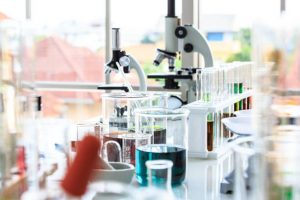
Choosing the most appropriate apparatus for your laboratory may be a time-consuming and exciting journey. Finding the greatest tools may be difficult, whether you are making your very first purchase of a product or you are upgrading old machinery to stay up with the rapidly evolving technologies of the present day.
Some pieces of equipment are necessary for each and every laboratory, despite the fact that the precise list may change depending on the requirements of your lab. Therefore, before you make any purchases, please review the following list of laboratory equipment:
- Spectrophotometers:
Spectrophotometers detect light intensity as a result of wavelength and are widely used to determine the concentration of a chemical in an aqueous solution. Different wavelengths of light can be studied depending on the type of spectrophotometer. Single beam and double beam spectrophotometers are available.
Before collecting measurements, a single beam spectrophotometer employs a reference standard to normalize or blank the instrument. A double beam spectrophotometer divides a light beam into two routes, one of which travels through the sample and the other via a reference standard. Other types of spectrophotometers include atomic absorption spectrophotometry and fluorescence spectrophotometers.
- Flame photometer:
A flame photometer is a piece of clinical laboratory equipment that measures sodium, potassium, lithium, and calcium ions in physiological fluids. The flame photometry principle is based on the fact that some elements’ compounds may be thermally dissolved in a flame and that some of the atoms formed due to this process can be driven to a higher energy level. A flame photometer is composed of three parts.
One advantage of flame photometry over atomic absorption or atomic emission spectrophotometry is its low cost. In addition, it is free of the spectrum and ionization interferences since ionization is only a problem at higher temperatures. In clinical research, the flame photometer offers numerous differential data for normal and abnormal sodium and potassium values.
- Incubators:
By regulating temperature, humidity, and CO2 factors, laboratory incubators provide a regulated, contaminant-free environment for consistent, safe work with cell and tissue cultures. Bacterial cultures are grown and preserved in microbiology incubators. Therefore, the first and most crucial considerations are the size and capacity of the incubator.
The appropriate internal volume may be determined by estimating the number of samples that will be incubated at any given moment. Because they provide regulatory compliance, Labec incubators are the best choice for use in accredited or licensed laboratories, which have been environments wherein precision and repeatability are of the utmost importance.
- Laboratory pumps:
Pumps are frequently used in laboratories to produce suction for sample filtering or aspiration and lower vapor pressure in devices such as rotary evaporators and lab ovens. Continuous-flow pumps, hazardous-area systems, and popular vacuum pumps, such as high-vacuum pumps, vacuum systems, and vacuum pump gauges, are all available.
Various liquid pumps dispense and transport fluids, including syringe, peristaltic, and metering pumps.
- Dissolution testers:
A chemical in tablet form must first dissolve in the patient’s stomach and be absorbed into the bloodstream before it can begin to act pharmaceutically on the patient. It might be challenging for medication developers to execute this simple initial step correctly.
To forecast how medications will behave in the body, it is necessary to understand how pharmaceuticals are released in vitro using a dissolution tester.
- Disintegration testers:
Disintegration testers assess how well a medicine in pellet form dissolves in solution. They, like dissolution testers, allow researchers and physicians to assess the in vitro disintegration of powdered substances for quality control.
- Water distillers:
Water stills, often referred to as laboratory water distillers, work by heating water to a volatile vapor phase to separate it from water-insoluble pollutants. Although the words “distilled water” and “deionized water” are sometimes used interchangeably, there are major distinctions between the sorts of pollutants that are removed from each type of water during the purification process.
In addition to removing charged ions, the distillation process of water may also remove microorganisms, non-volatile organic molecules, the vast majority of minerals, and various chemicals.
Final words:
There is no way to do scientific research without these essential tools mentioned above. But don’t think that means you won’t ever need anything else than this.
The lab equipment department has a large selection of glassware, chemicals, general equipment, measuring meters, heating elements, furnaces, temperature controls, and other lab accessories. It’s simple to get hold of most of them over the internet.